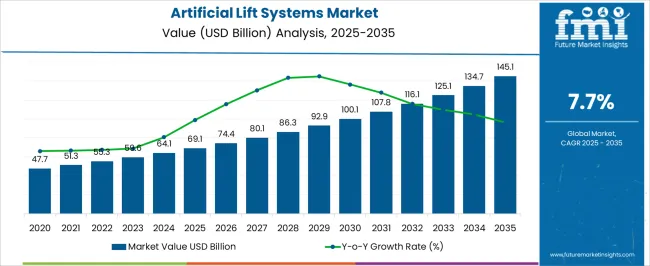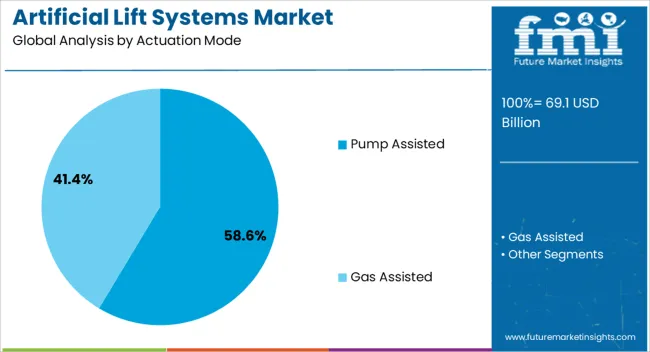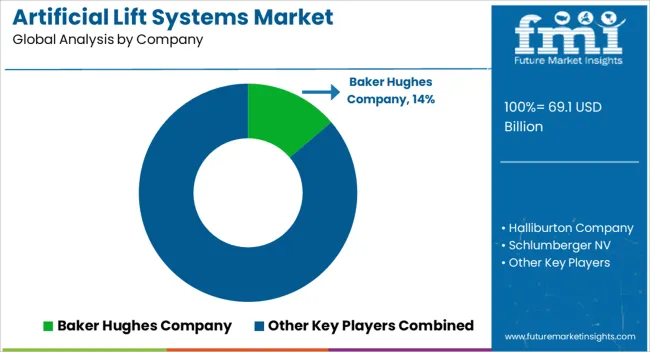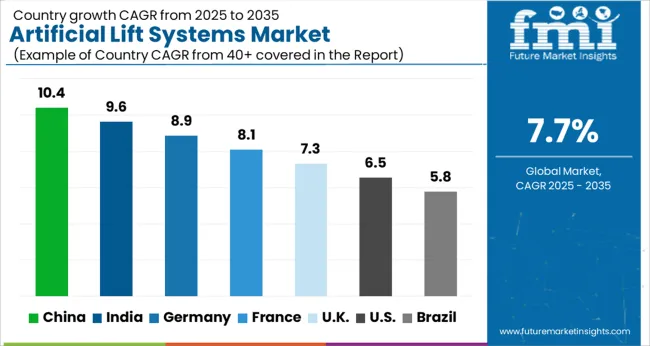The Artificial Lift Systems Market is estimated to be valued at USD 69.1 billion in 2025 and is projected to reach USD 145.1 billion by 2035, registering a compound annual growth rate (CAGR) of 7.7% over the forecast period.

| Metric | Value |
|---|---|
| Artificial Lift Systems Market Estimated Value in (2025 E) | USD 69.1 billion |
| Artificial Lift Systems Market Forecast Value in (2035 F) | USD 145.1 billion |
| Forecast CAGR (2025 to 2035) | 7.7% |
The artificial lift systems market is witnessing consistent expansion, driven by the increasing demand for efficient oil and gas production solutions in both mature and unconventional reservoirs. Rising global energy consumption and the ongoing need to optimize recovery rates from declining wells are reinforcing the adoption of advanced lifting technologies. The integration of digital monitoring, automation, and predictive analytics into artificial lift systems is enhancing operational efficiency, reducing downtime, and extending equipment lifecycles.
Growing investment in unconventional oil and gas projects, including shale formations, is further supporting demand for reliable and scalable lifting solutions. Additionally, operators are increasingly focusing on reducing production costs and improving energy efficiency, which is boosting the preference for systems that can be optimized through real-time performance data.
As oilfield operators adapt to fluctuating commodity prices and stricter environmental regulations, artificial lift systems are playing a pivotal role in ensuring sustainable extraction practices With ongoing technological innovation and expanding upstream exploration activities, the market is positioned for steady growth over the next decade.
The artificial lift systems market is segmented by actuation mode, and geographic regions. By actuation mode, artificial lift systems market is divided into Pump Assisted and Gas Assisted. Regionally, the artificial lift systems industry is classified into North America, Latin America, Western Europe, Eastern Europe, Balkan & Baltic Countries, Russia & Belarus, Central Asia, East Asia, South Asia & Pacific, and the Middle East & Africa.

The pump assisted actuation mode segment is projected to hold 58.6% of the artificial lift systems market revenue share in 2025, establishing itself as the dominant actuation method. Its leadership is being driven by its capability to provide consistent and reliable lift performance across a wide range of well conditions, including mature fields with declining reservoir pressure.
Pump assisted systems are increasingly being adopted due to their effectiveness in maximizing hydrocarbon recovery while maintaining lower operational risks compared to alternative methods. Advances in pump design and materials have enabled higher durability and efficiency, ensuring stable output even in challenging environments such as high-temperature or abrasive wells.
The ability to integrate pump assisted systems with digital monitoring technologies allows operators to optimize production rates, predict maintenance needs, and minimize downtime, further reinforcing adoption As oil and gas companies continue to prioritize cost efficiency and maximize reservoir yield, the pump assisted actuation mode is expected to retain its leading position in the market, supported by its adaptability, scalability, and proven performance in global upstream operations.
The global artificial lift systems market has been segment on the basis of geography as well as on the basis of actuation mode used for artificial lift system. On the basis of actuation mode, the global artificial lift systems market has been segmented into pump assisted artificial lift system and gas assisted artificial lift system.
The pump assisted artificial lift systems market has been further divided into four different systems, which include Rod Pump, Hydraulic Piston System, Electrical Submersible Pump (ESP), and Progressive Cavity Pump.
Further the gas assisted artificial lift system has been further segmented into two different types of systems – Gas Lift and Plunger Lift. Within the artificial lift systems market, rod pump has been the oldest types of methods that has been used across the industry. However, other artificial lift systems are expected to gain traction in the global artificial lift systems market in coming years.
In terms of geography, the global artificial lift system has been segmented into seven key geographical regions, which include, North America, Latin America, Western Europe, Eastern Europe, Asia Pacific (excluding Japan), Middle East & Africa, Japan.
The artificial lift system has witnessed a larger market share, in terms of revenue, as compared to other regions across the globe. Increasing mature fields in regions such as Middle East, is expected to drive the market for artificial lift systems through the forecast period.
The industry's inclination and attempts to optimize upstream assets is one of the key drivers for the global artificial lift systems market. Additionally, the recovery in crude oil price after recent plummeting is also likely to drive investments in global artificial lift systems market.
The desire to maintain the production rate in a well in addition to the cost effectiveness an artificial lift system provides as compared to tertiary recovery techniques, the artificial lift systems market is expected to witness increased revenue generation in years to come.

The global Artificial Lift Systems market witnessed key players such as Baker Hughes, Dover Artificial Lift, Flotek Industries, Inc., Halliburton Company, Kudu Industries, Schlumberger Ltd, Weatherford International, among others.
This research report presents a comprehensive assessment of the market and contains thoughtful insights, facts, historical data and statistically-supported and industry-validated market data and projections with a suitable set of assumptions and methodology. It provides analysis and information by categories such as market segments, regions, and product type.
The report is a compilation of first-hand information, qualitative and quantitative assessment by industry analysts, inputs from industry experts and industry participants across the value chain. The report provides in-depth analysis of parent market trends, macro-economic indicators and governing factors along with market attractiveness as per segments. The report also maps the qualitative impact of various market factors on market segments and geographies.

| Country | CAGR |
|---|---|
| China | 10.4% |
| India | 9.6% |
| Germany | 8.9% |
| France | 8.1% |
| UK | 7.3% |
| USA | 6.5% |
| Brazil | 5.8% |
The Artificial Lift Systems Market is expected to register a CAGR of 7.7% during the forecast period, exhibiting varied country level momentum. China leads with the highest CAGR of 10.4%, followed by India at 9.6%. Developed markets such as Germany, France, and the UK continue to expand steadily, while the USA is likely to grow at consistent rates. Brazil posts the lowest CAGR at 5.8%, yet still underscores a broadly positive trajectory for the global Artificial Lift Systems Market. In 2024, Germany held a dominant revenue in the Western Europe market and is expected to grow with a CAGR of 8.9%. The USA Artificial Lift Systems Market is estimated to be valued at USD 25.8 billion in 2025 and is anticipated to reach a valuation of USD 48.6 billion by 2035. Sales are projected to rise at a CAGR of 6.5% over the forecast period between 2025 and 2035. While Japan and South Korea markets are estimated to be valued at USD 3.7 billion and USD 2.2 billion respectively in 2025.
| Item | Value |
|---|---|
| Quantitative Units | USD 69.1 Billion |
| Actuation Mode | Pump Assisted and Gas Assisted |
| Regions Covered | North America, Europe, Asia-Pacific, Latin America, Middle East & Africa |
| Country Covered | United States, Canada, Germany, France, United Kingdom, China, Japan, India, Brazil, South Africa |
| Key Companies Profiled | Baker Hughes Company, Halliburton Company, Schlumberger NV, Weatherford International Plc, NOV Inc., Dover (Artificial Lift), Borets International Limited, ChampionX Corp, Alkhorayef Petroleum, JJ Tech, AccessESP, Odessa Separator, RAGHOEBAR, Novomet, Shengli Oilfield Highland, Torqueflow Sydex, Canadian Advanced ESP, and GE Power Conversion |
The global artificial lift systems market is estimated to be valued at USD 69.1 billion in 2025.
The market size for the artificial lift systems market is projected to reach USD 145.1 billion by 2035.
The artificial lift systems market is expected to grow at a 7.7% CAGR between 2025 and 2035.
The key product types in artificial lift systems market are pump assisted, _electrical submersible pump (esp), _rod pump, _hydraulic piston system, _progressive cavity pump, gas assisted, _electrical submersible pump (esp), _rod pump, _hydraulic piston system and _progressive cavity pump.
In terms of , segment to command 0.0% share in the artificial lift systems market in 2025.






Our Research Products

The "Full Research Suite" delivers actionable market intel, deep dives on markets or technologies, so clients act faster, cut risk, and unlock growth.

The Leaderboard benchmarks and ranks top vendors, classifying them as Established Leaders, Leading Challengers, or Disruptors & Challengers.

Locates where complements amplify value and substitutes erode it, forecasting net impact by horizon

We deliver granular, decision-grade intel: market sizing, 5-year forecasts, pricing, adoption, usage, revenue, and operational KPIs—plus competitor tracking, regulation, and value chains—across 60 countries broadly.

Spot the shifts before they hit your P&L. We track inflection points, adoption curves, pricing moves, and ecosystem plays to show where demand is heading, why it is changing, and what to do next across high-growth markets and disruptive tech

Real-time reads of user behavior. We track shifting priorities, perceptions of today’s and next-gen services, and provider experience, then pace how fast tech moves from trial to adoption, blending buyer, consumer, and channel inputs with social signals (#WhySwitch, #UX).

Partner with our analyst team to build a custom report designed around your business priorities. From analysing market trends to assessing competitors or crafting bespoke datasets, we tailor insights to your needs.
Supplier Intelligence
Discovery & Profiling
Capacity & Footprint
Performance & Risk
Compliance & Governance
Commercial Readiness
Who Supplies Whom
Scorecards & Shortlists
Playbooks & Docs
Category Intelligence
Definition & Scope
Demand & Use Cases
Cost Drivers
Market Structure
Supply Chain Map
Trade & Policy
Operating Norms
Deliverables
Buyer Intelligence
Account Basics
Spend & Scope
Procurement Model
Vendor Requirements
Terms & Policies
Entry Strategy
Pain Points & Triggers
Outputs
Pricing Analysis
Benchmarks
Trends
Should-Cost
Indexation
Landed Cost
Commercial Terms
Deliverables
Brand Analysis
Positioning & Value Prop
Share & Presence
Customer Evidence
Go-to-Market
Digital & Reputation
Compliance & Trust
KPIs & Gaps
Outputs
Full Research Suite comprises of:
Market outlook & trends analysis
Interviews & case studies
Strategic recommendations
Vendor profiles & capabilities analysis
5-year forecasts
8 regions and 60+ country-level data splits
Market segment data splits
12 months of continuous data updates
DELIVERED AS:
PDF EXCEL ONLINE
Artificial Ear Simulator Market Size and Share Forecast Outlook 2025 to 2035
Artificial Intelligence (chipset) Market Forecast and Outlook 2025 to 2035
Artificial Insemination Market Size and Share Forecast Outlook 2025 to 2035
Artificial Intelligence in Construction Market Size and Share Forecast Outlook 2025 to 2035
Artificial Tears Market Size and Share Forecast Outlook 2025 to 2035
Artificial Intelligence in Telecommunication Market Size and Share Forecast Outlook 2025 to 2035
Artificial Urinary Sphincter Market Size and Share Forecast Outlook 2025 to 2035
Artificial Intelligence in Retail Market Size and Share Forecast Outlook 2025 to 2035
Artificial Intelligence (AI) in Automotive Market Size and Share Forecast Outlook 2025 to 2035
Artificial Intelligent Packaging Market Size and Share Forecast Outlook 2025 to 2035
Artificial Intelligence in Healthcare Market Size, Growth, and Forecast for 2025 to 2035
Artificial Ventilation and Anaesthesia Masks Market Size and Share Forecast Outlook 2025 to 2035
Artificial Intelligence In Cybersecurity Market Size and Share Forecast Outlook 2025 to 2035
Artificial Pancreas Device Market Size and Share Forecast Outlook 2025 to 2035
Artificial Flower Market Analysis by Growth, Trends and Forecast from 2025 to 2035
Artificial Preservative Market Outlook by Product, Type, Form, End Use Application and Others Through 2035
Artificial Hair Integration Market Growth - Trends & Forecast 2025 to 2035
Artificial Intelligence in Military Market Analysis - Size & Forecast 2025 to 2035
Analysis and Growth Projections for Artificial Sweetener Business
Artificial Turf Market Growth & Trends 2024-2034

Thank you!
You will receive an email from our Business Development Manager. Please be sure to check your SPAM/JUNK folder too.
Chat With
MaRIA